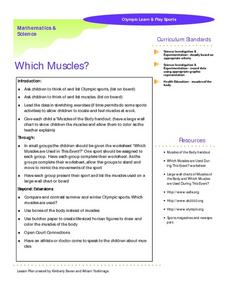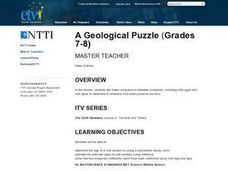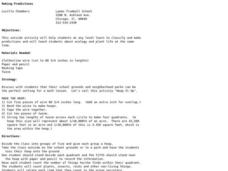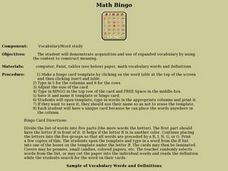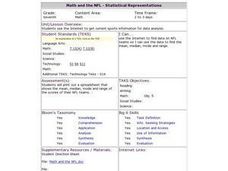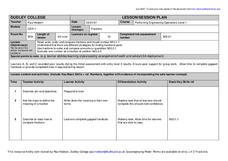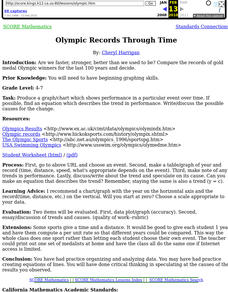Alabama Learning Exchange
Inner and Outer Planets
Young scholars explore the solar system. In this planets instructional activity, students learn about the other planets in the solar system. They watch a video clip from National Geographic on the solar system, compare and contrast the...
Curated OER
Climb Every Volcano
Students use a contour map to distinguish the elevation of a volcano. In this volcano lesson plan, students use styrofoam to create the contour of their map. Students glue and assemble their volcano. Students compare and contrast...
Curated OER
How many seeds?
Learners investigate seeds and find the difference between seeds and nuts. In this seeds and nuts activity, students predict, then count the number of seeds in an apple. Learners record and share their results. Students compare seeds...
Curated OER
Castle/Fort Unit
Young scholars compare and contrast castles and forts. They observe buildings in their community and consider how castles and forts are similar. They design their own castle or fort and brainstorm materials to build with, discuss how the...
Curated OER
Less is More: Realizing Mathematics Through Agriculture
Learners study the architectural designs of different popular sites. For this math lesson, students draw a grid diagram. They explain what geodesic algorithms are used for.
Curated OER
Which Muscles?- Olympic Learn and Play Sports
In this math, science, and physical education worksheet, students brainstorm and study about the muscles that are used while participating in different Olympic sports. They color the muscle groups of the body by follow the directions...
Curated OER
How Plants Help Us Breathe
Third graders discuss how humans breathe and how plants help us to stay alive. In groups, they identify and label the different parts of plants and describe their functions. They compare and contrast the ways plants and animals breathe...
Curated OER
A Geological Puzzle
Young scholars compare and contrast the various types of rocks on each continent. In groups, the calculate the rock ages and types to determine if the continents, in their opinion, were joined at one time. They develop two imaginary...
Curated OER
Making Predictions
Students collect and classify items. In this making predictions lesson, students go outside and collect specimens of plants, insects and minerals. They classify each item and place them in a Venn Diagram. Students compare and contrast...
Curated OER
Neighborhoods
Students examine homes around the world. In this multicultural lesson, students read the book A World of Homes and Homes Around the World. Students compare and contrast the homes in the books to their own homes. Students construct a...
Curated OER
Adventures along the Oregon Trail in Nebraska
Pupils discover how the land and people we develop relationships with in Nebraska affect our survival--past, present, and future. They write about and interview their grandparents, parents and peers and compare them with people on the...
Curated OER
What's Your Favorite Planet?
Fourth graders interpret a graph and make correlations using data. After taking a class survey, 4th graders create a class graph of their favorite planets. Working in small groups, they interpret the information and create at least ten...
Curated OER
Math and Cinderella
Pupils trace their feet and them compare the different sizes of classmates. They construct a bar graph showing the results of their classmates' feet size. They discuss what kinds of conclusions can be drawn from their observations.
Curated OER
What is Your Future Worth?
Students use the "StocksQuest Calculator" to calculate the future value of an investment. They compare and contrast investing in the S&P 500 to CDs, T-bonds or bank accounts.
Curated OER
Math Bingo!
Students discover how to change units of measurement by multiplication and division applications. They play math bingo solving multiplication and division problems. Students review their anwers by checking them in class.
Curated OER
Triangles Inscribed in a Circle
Are you tired of answers without understanding? Learners can give a correct response, but do they really understand the concept? Have young mathematicians think deeper about linear functions, angles, and formulas in algebra. Learners are...
Curated OER
Math and the NFL - Statistical Representations
Seventh graders use the Internet to get current sports information for data analysis. They use their data to find the mean, median, mode and range. Students then place their data on a spreadsheet.
Curated OER
Gingerbread Math
Students practice addition facts. In this addition lesson, students get an addition problem to solve. If they get it correct, they open up a door on a gingerbread house which gives a decoration to add to a gingerbread man.
Curated OER
Sort It Out and Match It Up
Students identify objects that are the same shape and size. They compare and contrast attributes of two-and three-dimensional objects using appropriate vocabulary. Pupils justify an extension of a geometric pattern to explain what was...
Curated OER
Fractions
In this mathematics learning exercise, students read, write, order and compare fractions and mixed numbers. They identify that there are various strategies for finding fractional parts and use fractions to order and compare amounts or...
Curated OER
Olympic records through time
Pupils compare the records of gold medal Olympic winners for the last 100 years and decide if we are faster, stronger than in the past.
Teach Engineering
Properties of Mixtures vs. Solutions: Mix It Up!
Now it becomes crystal clear why the unit is called Mixtures and Solutions. The fifth installment of a six-part unit explores mixtures and solutions. After viewing a demonstration on mixing pebbles with water, salt with water, and...
Virginia Department of Education
Quadrilateral Sort
If only you had a Sorting Hat to sort out quadrilaterals. Learners sort cutouts of quadrilaterals based on their properties and attributes. A flowchart helps them organize the results of the activity.
Virginia Department of Education
Complex Numbers
Build on your class' understanding of real numbers as they begin working with complex numbers. Pupils begin with an exploration of i and the patterns in the powers of i. After developing a definition for i, they simplify complex number...







